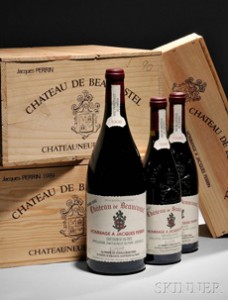TIP OF THE DAY: Grenache (Garnacha) For Fall & Winter
|
The third Friday of September—the 18th this year—is International Grenache Day. With its high alcohol content and spicy notes, it’s an excellent wine for autumn and winter food pairings (see below).
Grenache (gruh-NOSH) in French, Garnacha in Spanish, is easy to grow and thus one of the most widely planted red wine grape varieties in the world. Because pure Grenache wines (monovarietals) tend to lack acid, tannin and rich color, the grape is often blended with other varietals. For red Grenache, these are chiefly: The high sugar levels of Grenache make it good for fortified wines, as well. It is used in most Australian fortified wines and in the Port-like red vins doux naturels of Roussillon, France such as Banyuls, Maury and Rasteau. Today, narrow down your options and try a red Grenache or Garnacha. What should you try it with? |
A glass of Grenache. It’s hard to tell Grenache by its color, since most are blended with other grapes. A Grenache blend with Syrah or Temperanillo, for example, will be much more purple than a 100% Grenache. Photo courtesy Semata. |
|
|
FOOD PAIRINGS WITH RED GRENACHE Red Grenache is a versatile wine, even though—as with any wine—its flavors vary, depending on where the grapes are grown, the soil and microclimate characteristics and diverse winemaking styles among producers. But red Grenache is generally spicy* with raspberry or strawberry notes. As the wine ages, leather and tar flavors can emerge. Pair red Grenache with: |
||
 One of our favorite grenache blends, Chateau de Beaucastel from the Châteauneuf-du-Pape region of the Rhone. Châteauneuf-du-Pape reds tend to be earthy and gamy flavors, with hints of tar and leather: big, lush wines that are terrific with roast beef or lamb. Photo courtesy Skinner Inc. |
FOOD PAIRINGS WITH WHITE GRENACHE
salmon and tuna) Garnacha most likely originated in the Aragon region of northern Spain. In the 12th century it spread to Catalonia and other regions under the Crown of Aragon. When the Roussillon region was annexed by France, Garnacha became Grenache, and the grape was planted in Languedoc and the Southern Rhone region. The latter is the home of perhaps the world’s greatest grenache blend, the A.O.C.† Châteauneuf-du-Pape. |
|
|
†Appellation d’origine contrôlée (AOC), or controlled designation of origin, is the French certification granted to certain wines, cheeses, and other agricultural products made in specific geographical areas, from local ingredients and according to time-honored artisanal practices. The terroir of the region and the artisan techniques assure the authenticity of the product.
|
||
